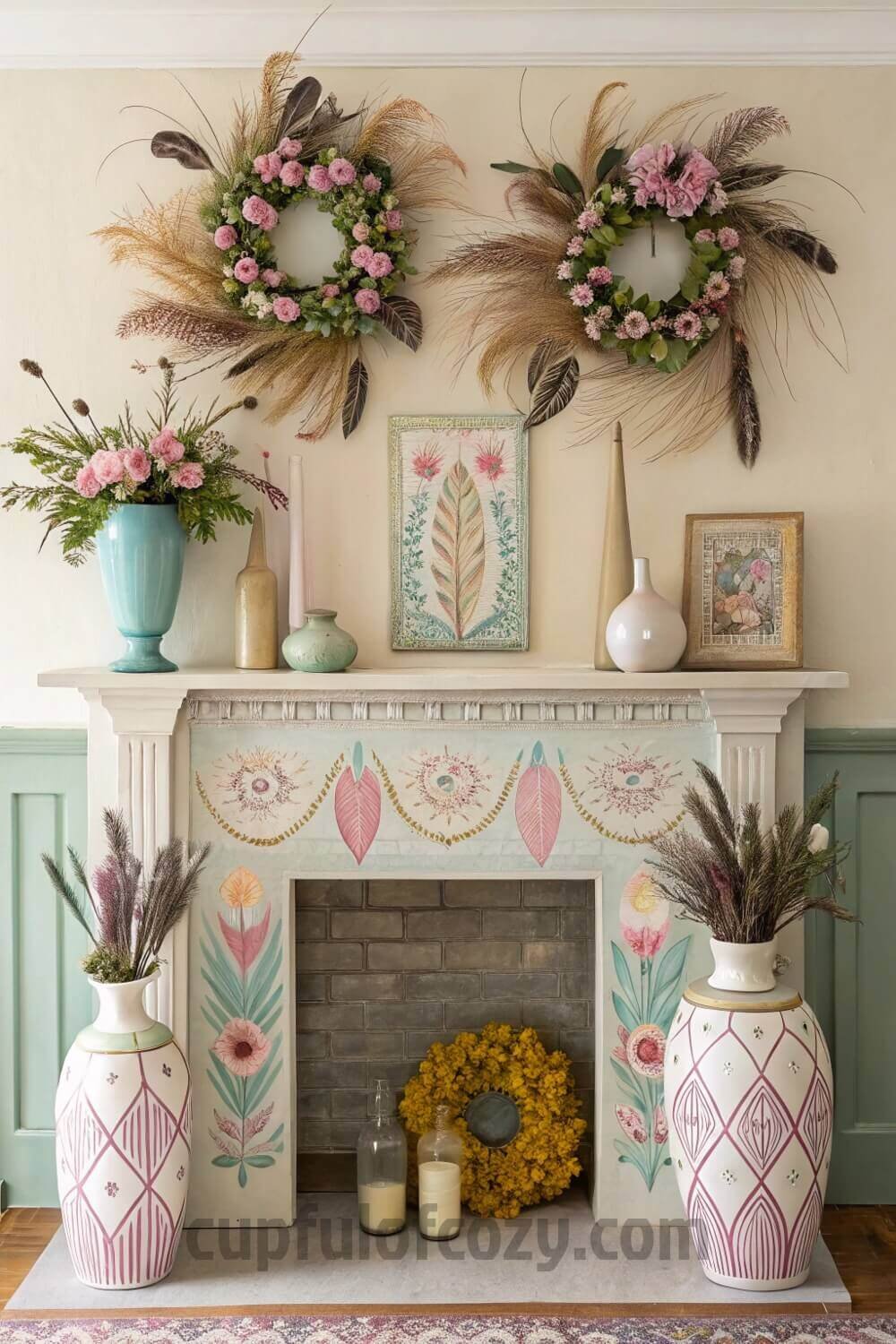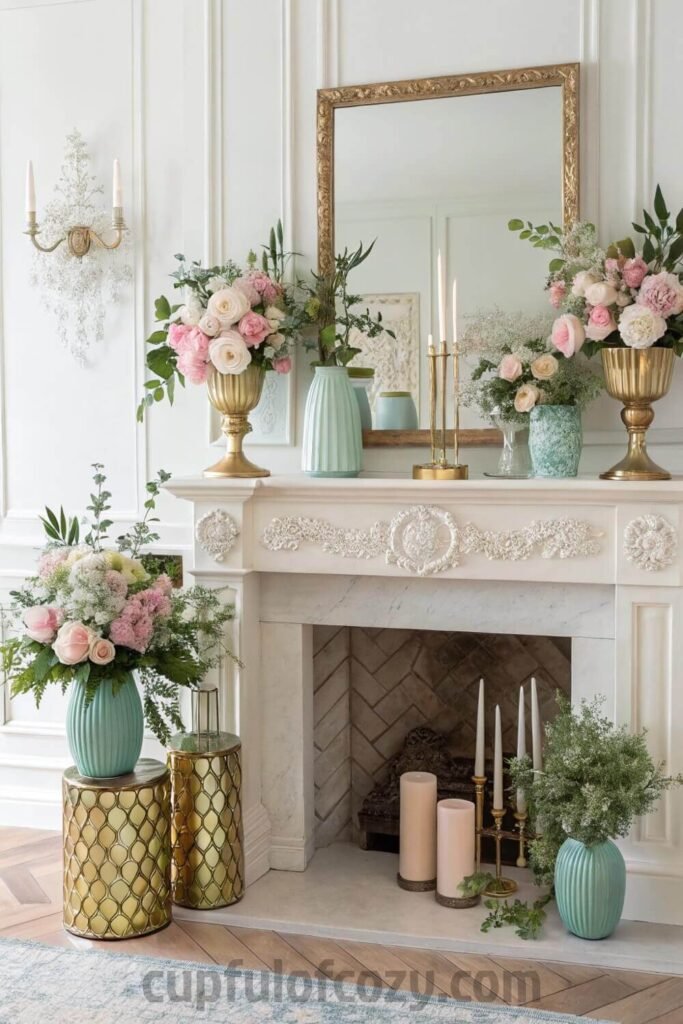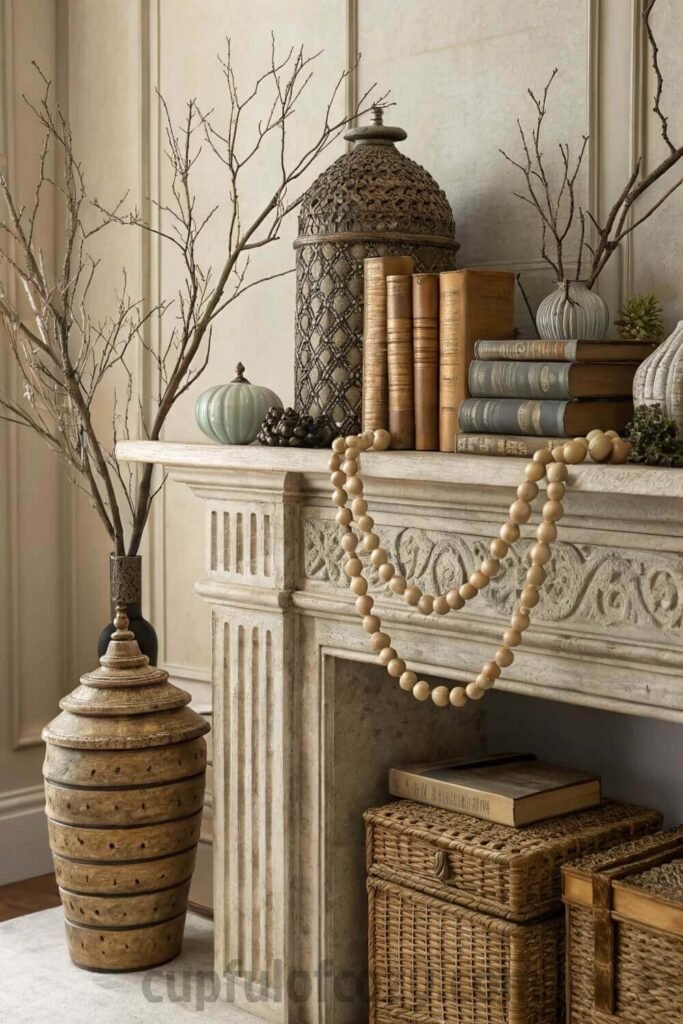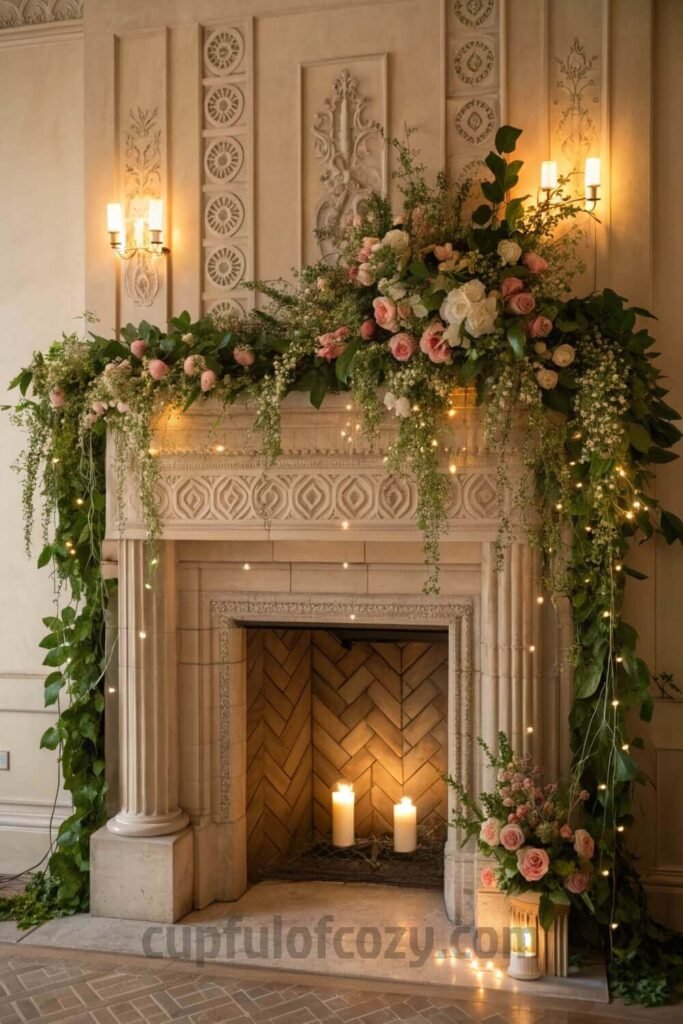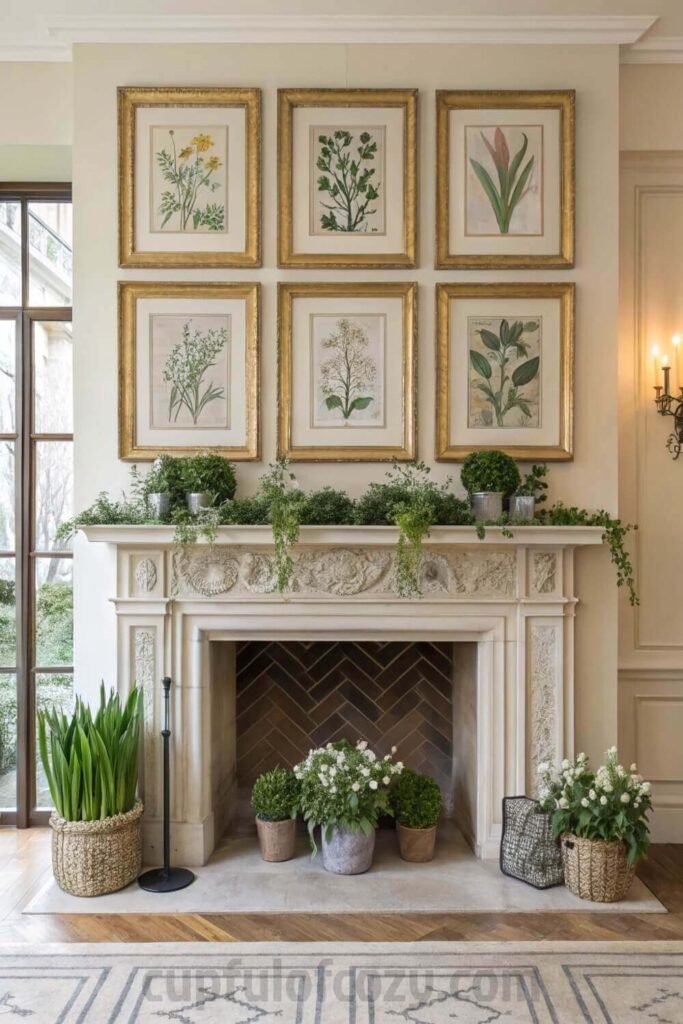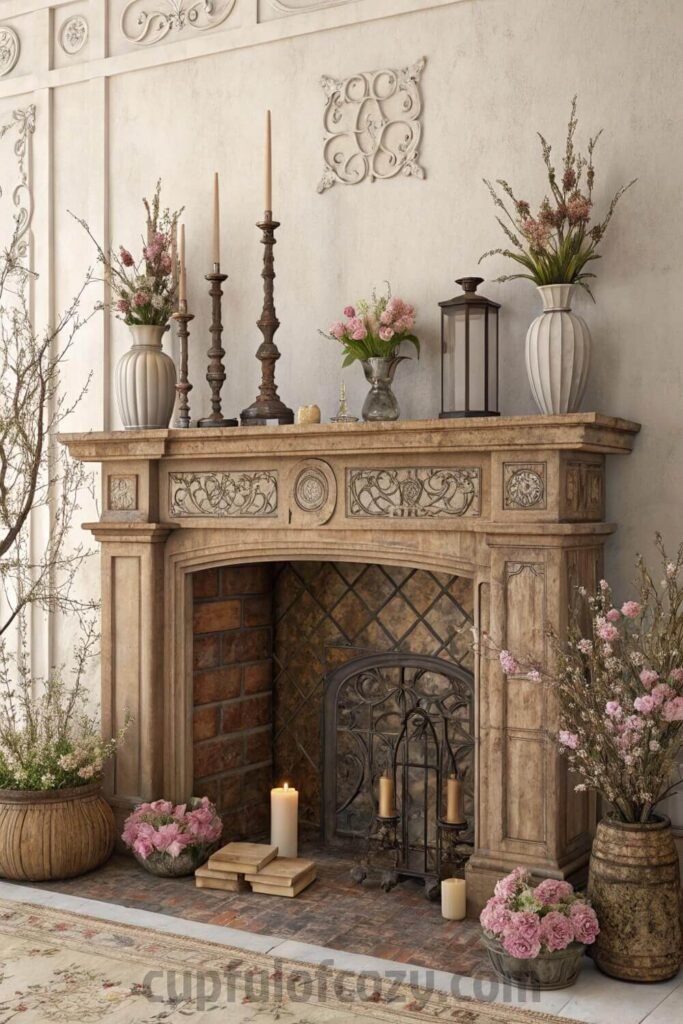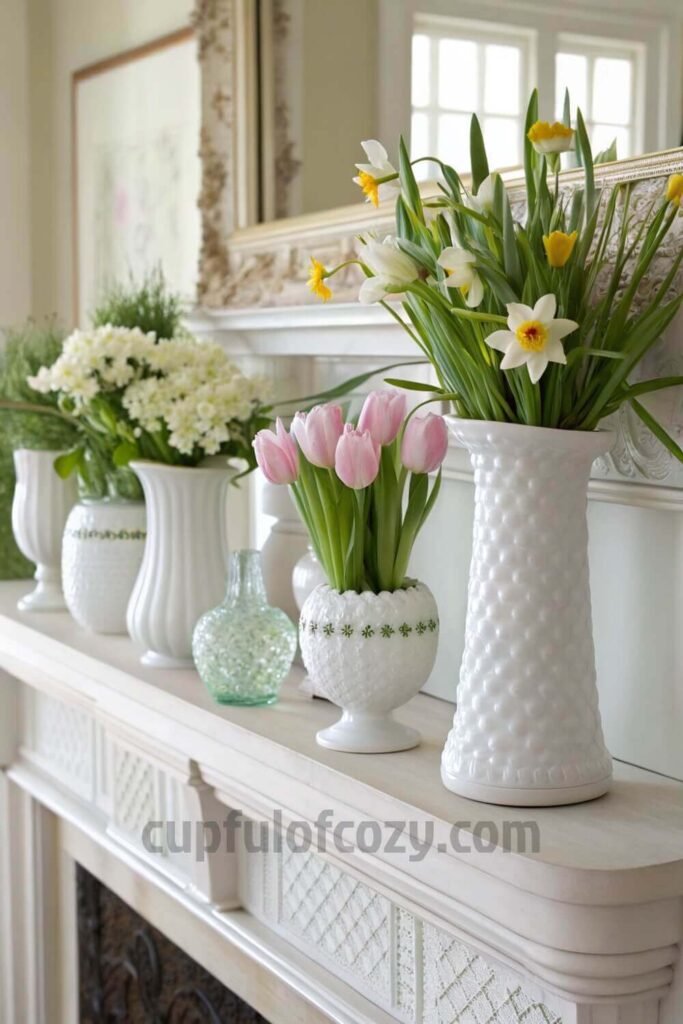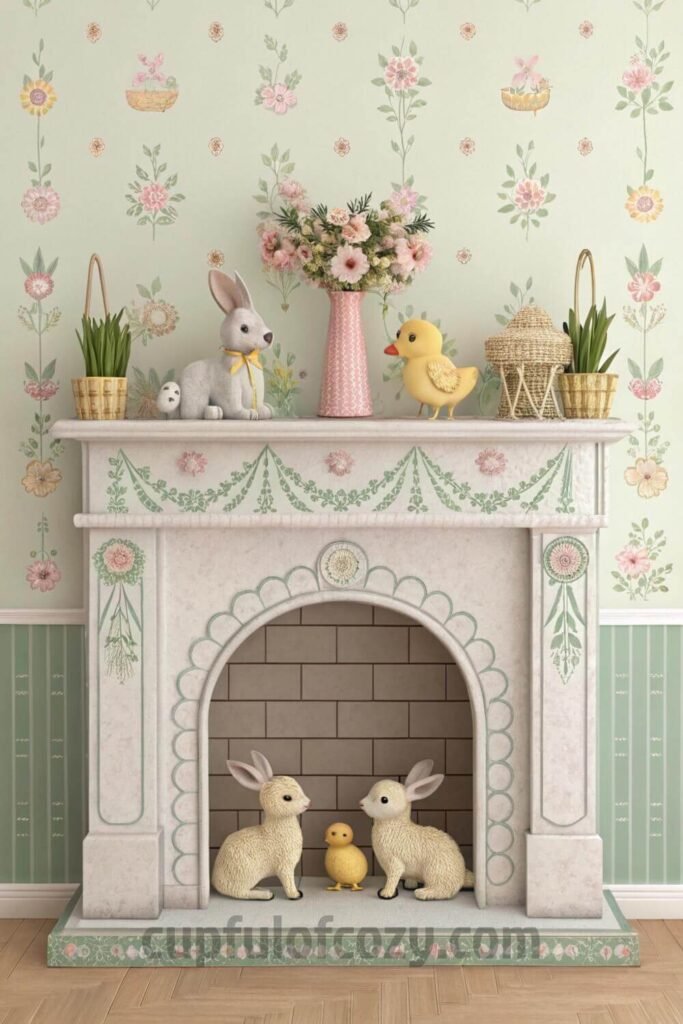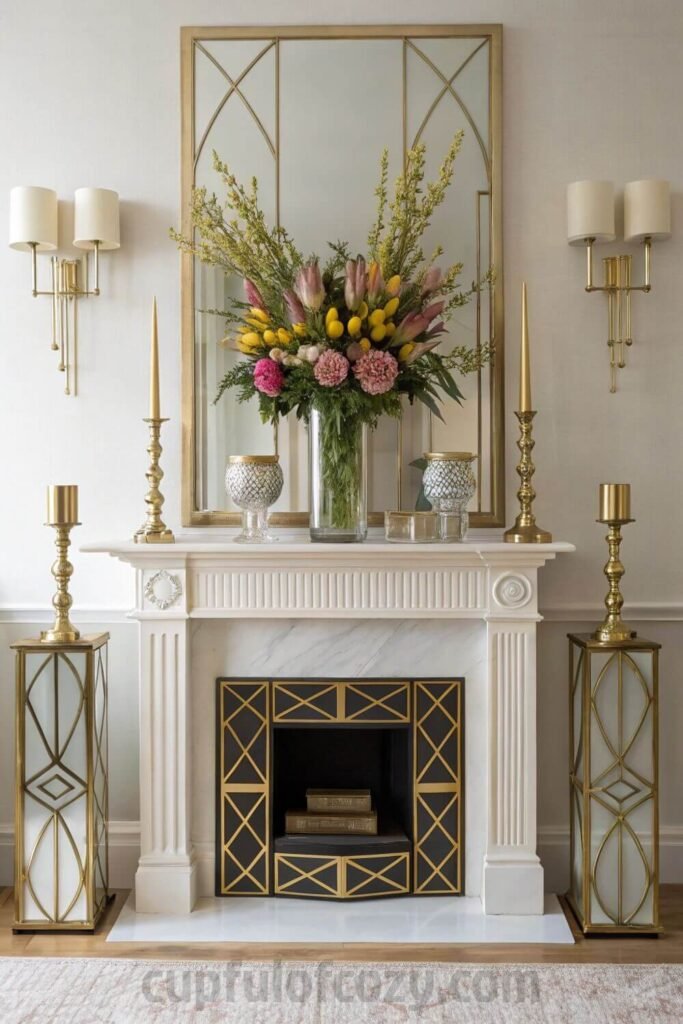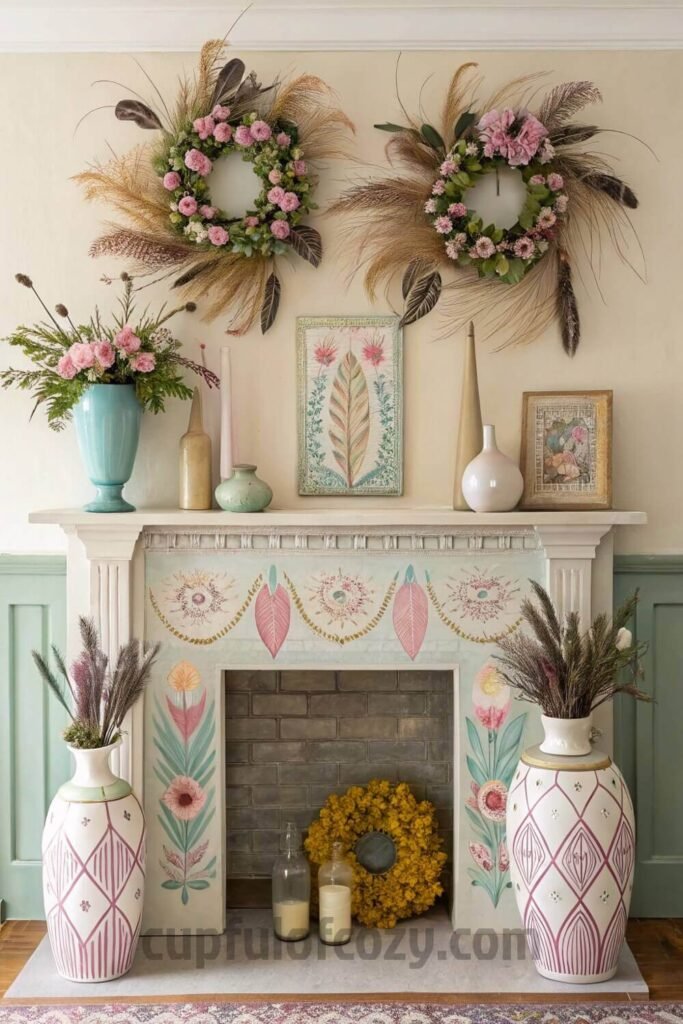I was helping my neighbor clean out her late mother’s house last fall, right? We’re going through all these dusty boxes in the basement, and I pull out this gorgeous 1920s brass geometric vase that just stopped me dead in my tracks. The weight of it, the way the light hit those angular lines, something just clicked. Her mom had been an interior designer back in the day, and apparently had this incredible eye for Art Deco pieces that nobody in the family really appreciated.
That one vase sitting on my boring builder-grade mantel looked so out of place but so right at the same time, you know what I mean? It was like it was calling out for friends. So naturally, I started haunting estate sales and antique shops, collecting these amazing pieces without really having a plan. Then spring rolled around, and I’m looking at my mantel thinking it needs some life, some freshness, but everything I tried looked either too cutesy Easter bunny or too modern minimalist. Neither felt like me.
That’s when it hit me: what if I could blend that sophisticated Art Deco glamour with all the fresh, optimistic energy of spring? Not the Pinterest-perfect version everyone’s doing, but something that feels authentic and personal and maybe a little unexpected. I started experimenting, mixing my vintage finds with spring elements, and honestly, the results blew me away. Every time someone walks into my living room now, they stop and stare at that mantel. Not because it’s perfect, but because it tells a story and creates this mood that’s both elegant and alive.
These aren’t the typical spring decorating ideas you’ll find everywhere else. They’re the discoveries I’ve made through months of trial and error, conversations with antique dealers who actually lived through that era, and yes, a few spectacular failures that taught me what not to do. If you’re tired of the same old tulips-and-gingham approach to spring decorating, and you want something with more personality and sophistication, then settle in because I’m about to share everything I’ve learned.
Table of Contents
1. That Perfect Spring Color Story with Art Deco Drama
Here’s what nobody tells you about spring decorating: pastels don’t have to be boring or predictable. Last month at this incredible antique mall in Taos, I found this display that completely changed how I think about color. The dealer had arranged these soft blush pink Depression glass pieces with brass Art Deco candlesticks and sage green pottery, and the combination was breathtaking. Not sweet or precious, but sophisticated and fresh.
My approach now starts with those dreamy spring shades, soft blues like a March sky, that perfect buttery yellow that makes you think of daffodils, and fresh greens that remind me of new leaves. But instead of keeping everything light and airy, I anchor it with those bold Art Deco elements: geometric brass pieces, black lacquered frames, maybe a vintage mirror with etched details. The contrast creates this incredible depth that feels both historical and completely current.
What I love most is how this color story changes throughout the day. Morning light makes those pastels absolutely glow, but when evening comes and I light my vintage brass candles, those metallic accents catch the flame and everything feels warm and glamorous. It’s like having two completely different rooms in one.
2. Playing with Heights Like You’re Creating a Cityscape
My dad always said decorating was like building a little city, and now I finally get what he meant. Art Deco was all about those dramatic vertical lines, those soaring buildings reaching toward the sky. When I style my mantel, I think about creating that same kind of architectural rhythm.
I start with my tallest pieces, usually a pair of brass candlesticks or this incredible fluted vase I inherited from my grandmother. Then I work my way down with medium-height geometric planters and vintage books stacked just so. The secret is in the spacing and the way each piece relates to the others. I learned this from studying old photographs of 1920s apartments: nothing ever sits alone, everything is part of a larger composition.
The texture play is just as important as the height variation. I’ll drape vintage bead garlands between pieces to create visual bridges, or add a woven basket filled with pussy willow branches. These organic elements soften all those strong geometric lines without losing that sophisticated Art Deco structure. When I step back and look at the whole arrangement, it should feel like a carefully orchestrated conversation between all the different pieces.
3. Garlands That Look Like They Grew There Naturally
- Before you hit “buy” on your next decor order, there’s a free 10-second step you should never skip: checking Rakuten (Ebates). I simply find the store name, click the deal, and shop like normal, and Rakuten sends me real cashback! Prices keep climbing everywhere, but this is one way to get a little back on the things you were going to purchase anyway. New members even get a $30 bonus when they spend $30 — which means your first order could pay you back instantly. Don’t miss out again. Click here to sign up and save money!
*Disclosure: This post includes affiliate links. I may earn a small commission if you join Rakuten through my link — but it doesn’t cost you anything extra. In fact, you’ll actually save more!
I spent way too many springs trying to make those picture-perfect garlands you see in magazines, and they always looked stiff and artificial. Then my neighbor, who’s this amazing gardener, showed me her approach: let the plants do what they want to do naturally, then work with that.
Now I create these cascading arrangements using whatever’s blooming in my yard, eucalyptus and white flowering branches, sometimes wild grape vines if I can find them. The secret is letting them drape and curve organically across the mantel, not trying to force them into some predetermined shape. I weave in these tiny battery-operated lights, nothing flashy, just enough to create a warm glow when the sun goes down.
My favorite discovery was using flowering cherry branches from the tree in my backyard. They only last about a week, but during that time, my whole living room smells like spring and the delicate pink blooms look incredible against my brass and glass collection. It’s temporary and perfect, and somehow that makes it even more special.
4. Botanical Prints That Feel Like Family Heirlooms
Three years ago, I inherited a box of botanical prints from my great-aunt Rose, who apparently had incredible taste but nowhere to display everything. They’d been sitting in my closet because I couldn’t figure out how to make them work with my modern space. Then I found these Art Deco frames at an estate sale, all different sizes but with the same geometric style, and everything clicked.
I created this layered gallery on my mantel, some prints framed, others just leaning casually against the wall. What makes it special is mixing them with actual living plants. I have this trailing pothos in a vintage milk glass planter that creates this beautiful connection between the botanical art and real greenery. Sometimes I’ll stick a single stem in a small vase right in front of one of the prints, like the flower is growing right out of the artwork.
What I really love is how each print has its own personality. There’s this gorgeous fern illustration that reminds me of walks in the woods with my grandmother, and a delicate violet print that just makes me smile every time I see it. They’re not just decoration, they’re little windows into the natural world that feel both vintage and timeless.
5. The Adventure of Finding an Authentic Vintage Mantel
This was probably my craziest decorating decision ever. I was scrolling through online classifieds last winter, not really looking for anything specific, when I saw this listing for a 1930s mantel from a house renovation. The photos were terrible, but something about those carved details called to me.
My cousin Sarah and I drove three hours to look at it, and when we walked into that dusty warehouse, I knew immediately it was coming home with me. The original plaster work, the perfect patina that takes decades to develop, those incredible proportions that modern mantels just can’t replicate. Getting it installed was a whole other adventure, but now it’s the centerpiece of my entire living room.
Styling an authentic vintage mantel is completely different from working with modern pieces. Every architectural detail is an opportunity to highlight something special. I use old corbels as display stands, nestle small arrangements in the carved nooks, and let my antique brass candlesticks echo the period details. It’s like the mantel tells me where everything should go, instead of me imposing some arbitrary design on it.
6. Milk Glass Treasures That Catch the Light
I never understood the appeal of milk glass until I saw how it looks on my mantel at different times of day. That soft, translucent quality does something incredible with light, especially spring light that’s just starting to get strong and clear. My collection started small, just a few pieces from garage sales and thrift stores, but now I have enough to create these gorgeous groupings that change with the seasons.
For spring, I fill my milk glass vases with the simplest things: pussy willow branches that I cut from the vacant lot behind my house, white tulips from the grocery store, sometimes just interesting branches I find on walks. The milk glass makes everything look more elegant and intentional, even grocery store flowers suddenly look like they belong in a sophisticated Art Deco apartment.
The best discovery was learning how milk glass plays with my brass and chrome pieces. The soft, diffused light from the milk glass balances all those sharp metallic reflections, creating this wonderful harmony between hard and soft elements. It’s become the secret ingredient that ties my whole spring mantel together.
7. Little Animal Friends That Spark Joy
Here’s where I might lose some of you, but stay with me on this one. I have these tiny vintage animal figurines scattered among my more serious Art Deco pieces, and they’re conversation starters every single time someone visits. There’s a little brass lamb from the 1940s that my mom found at an antique mall, and a ceramic bunny with the most perfect Art Deco styling that I discovered at an estate sale.
My friends were skeptical at first, thought they might be too cutesy for the sophisticated look I was going for. But when you place them thoughtfully among geometric vases and sleek candlesticks, they add this wonderful touch of whimsy that keeps everything from feeling too serious or museum-like. They remind me of the kind of decorative objects you’d find in a glamorous 1920s apartment, sophisticated but personal.
The real test was when my interior designer friend came over and immediately fell in love with that little brass lamb. She said it was the kind of unexpected detail that makes a room memorable, and I think she’s right. Sometimes the smallest touches have the biggest impact on how a space feels.
8. Creating Balance Without Being Boring
Art Deco design is famous for its strong geometric symmetry, but the trick is making that balance feel natural rather than rigid. I learned this by studying old photographs of period rooms: everything has order and structure, but there’s still personality and life in the arrangements.
My approach starts with anchor pieces on either end of the mantel, usually matching brass candlesticks or geometric planters. Then I build toward the center with gradually increasing heights, like steps leading up to the focal point. But I keep the symmetry loose enough to feel organic. Maybe one side has a small figurine that the other side doesn’t, or the flowers in one vase drape slightly differently than the other.
What makes this work is maintaining the same visual weight on both sides without making everything identical. Two different vases that are similar in size and style can create balance while still having their own character. It’s sophisticated without being predictable, structured without being stiff.
9. Mixing Old and New Like a Curator
This is where I get really excited about styling because it’s like solving a visual puzzle. I love taking authentic vintage Art Deco pieces and pairing them with carefully chosen modern elements that complement rather than compete. A 1920s brass mirror looks incredible next to a contemporary white ceramic planter, or I’ll put fresh tulips from the farmer’s market in a genuine vintage geometric vase.
The secret is understanding what makes each era special and finding the common threads. Both Art Deco and modern design celebrate clean lines and geometric forms, so they naturally play well together. The vintage pieces bring history and character, while the modern elements keep everything feeling fresh and relevant.
This approach is also way more budget-friendly than trying to furnish entirely with authentic pieces. You can invest in a few really special vintage items and supplement with modern pieces that enhance rather than distract. Plus, it creates layers of visual interest that pure period rooms sometimes lack.
10. Personal DIY Touches That Tell Your Story
I’m usually more of a collector than a creator, but there’s something satisfying about making a few personal touches for your mantel display. Last winter I took some plain ceramic vases I found at a thrift store and painted them in this perfect sage green that coordinates with my spring color palette. They’re not masterpieces, but they’re exactly the right color and size for what I needed.
My favorite project was creating simple wreaths using vintage millinery supplies I’ve been collecting for years. Antique shops always have boxes of old feathers, silk flowers, and interesting trim that were probably destined for hat making decades ago. I arrange them into loose, organic shapes that complement my more structured Art Deco pieces.
These handmade elements add something you can’t buy: the story of an afternoon spent creating something beautiful while listening to Billie Holiday records. Every time I look at them, I remember that peaceful creative time, and somehow that memory becomes part of how the whole mantel feels. They’re imperfect in the best way, personal touches that make the space uniquely mine.
The thing about Art Deco vintage spring styling is that it’s not just about following a formula or copying someone else’s look. It’s about understanding the principles of that incredible design era and interpreting them through your own lens and lifestyle. These ideas work because they honor the sophistication and glamour of Art Deco while embracing the fresh, optimistic energy that makes spring so wonderful. When you walk into a room styled this way, you should feel both the elegance of the past and the possibility of the present, and that combination is pretty irresistible.
Related posts:
11 Cheap Nature-Inspired Clear Ornament Ideas with Pine, Cinnamon & Dried Oranges
10 Gothic Mirror & Makeup Corner Ideas That Feel Hauntingly Glam
9 Budget-Friendly DIY Jolly Holly Cards with Stamped and Embossed Designs Using Dollar Store Supplie...
10 Stunning The Nightmare Before Christmas Decor with a Jack Skellington Theme That Mix Halloween an...
- Before buying anything online, check Rakuten (formerly Ebates) — either with the browser extension or directly on Rakuten.com. Just type in your store, click the current deal, and shop as usual. Every purchase earns you cashback that can be mailed to you or sent via PayPal. In today’s economy, even a few dollars back can turn into a Starbucks latte, McDonald’s fries for the kids, or a little treat you don’t have to budget for. If you’ve never used Rakuten before, you’re missing out on free money — and right now, you’ll even get a $30 bonus when you spend your first $30. Click here to sign up and stop letting your online orders steal from you. Click here to sign up and save money!
*Disclosure: This post includes affiliate links. I may earn a small commission if you join Rakuten through my link — but it doesn’t cost you anything extra. In fact, you’ll actually save more!

